
Christian Philosophy & Culture
The Christian Church: The Church Building (Part 2 of 4)
Christian life is based on two essential truths: the one is the redemptive sacrifice of Christ, and the need to participate in this sacrifice, to be identified with it in order to be saved, the need for everyone to recapitulate, to repeat, so to speak, the sacrifice in his own soul. The other essential truth-the purpose, the result, and the very meaning of this sacrifice is the transfiguration of man and with him of the whole visible world, which was dragged down by man in his fall. This is what peace between God and the world means. It is this second truth which constitutes the principal subject of the symbolism of the church. In fact, the whole of God's revelation to man, and the immensity of the sacrifice made by God for the salvation of mankind, on the one hand, and everything that man brings to God, on the other hand, is all directed towards one and the same goal: towards what the Fathers of the Church call the heavenly Jerusalem, the Kingdom of God. Without this perspective, which gives to our every action and our every prayer its full significance, our faith would be meaningless. It is exactly this orientation towards the future, this building of the future, which distinguishes Christian worship from all others. The service may be conducted in different languages. Likewise, a church may vary in shape: for instance it may take the form of a cross, a basilica, or a rotunda; it can be built according to the taste and ideas of one period or another, of one people or another; but its significance was, is and always will be the same. Each nation expresses its characteristics in its church buildings. But this diversity of form only serves to emphasize the underlying unity of meaning, the confession of one and the same truth.
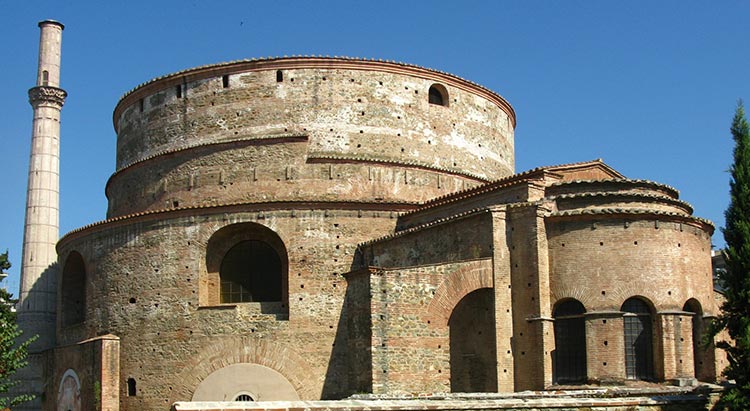 Above: Τhe Rotunda of Galerius, 4th century, Thessaloniki, Greece
Above: Τhe Rotunda of Galerius, 4th century, Thessaloniki, Greece
As early as the first quarter of the fourth century, Eusebius, in a homily on the consecration of a church in Tyre, develops in great detail the symbolism of this building. His fundamental idea is that what we see in a church is identical with what we hear. The building corresponds to the service which is celebrated there. Moreover, the visible church is built in the image of the invisible Church, and bears an essential likeness to her. It is the house of God, for God dwells there with the faithful who are the vessels of His Spirit. It is heaven on earth, the world of the age to come, where God is all in all. The beauty of a church seems in some measure to unveil the beauty of the heavenly Jerusalem which God prepares for those who love Him (6).
But Eusebius does not confine himself to commenting on the church as a whole; he goes on to explain its parts: the sanctuary (cut off by a screen to prevent the people from approaching the altar), the nave and the narthex. Eusebius has the merit of reflecting the attitude of mind of the Church of his day, and of reporting authentic facts of which he was an actual witness.
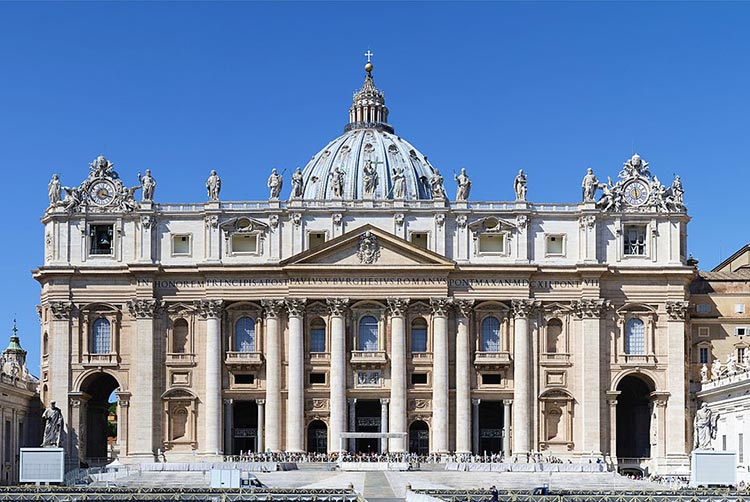 Above: St Peter's basilica, 17th century, Rome, Italy
Above: St Peter's basilica, 17th century, Rome, Italy
It was during the seventh and eighth centuries especially that the symbolism of the church attained its most complete theoretical formulation. The most systematic commentaries are to be found in the Mystagogia of St. Maximus the Confessor (seventh century), who has also left a remarkable study of the Liturgy; in the writings of St. Sophronius, Patriarch of Jerusalem (seventh century); of St. Germanus, Patriarch of Constantinople (died 740), the great confessor of Orthodoxy during the iconoclast period; and of St. Simeon, Archbishop of Salonica (fifteenth century). These same centuries, he seventh and eighth, so rich in writings on symbolism, are also a time of great activity in the composition of liturgies, the period of the great authors of canons: St. Andrew of Crete, St. Cosmo of Maioum, St. John of Damascus.
In studying these commentaries, it should never be forgotten that they do not only express the subjective opinion of their authors. The symbolism of the church is founded objectively in the essence of Christianity, and it expresses a well-defined reality, the liturgical life, which is one of the principal aspects of tradition. That is why St. Simeon of Salonica starts his essay On the Divine Temple with the words: "We pass on to you with love what we have drawn from the Fathers; for we have nothing new to add to what has been passed on to us, nor have we in any way modified it, but we have preserved all things, as a symbol of faith, in the state in which they were given. We celebrate the services exactly as Christ Himself and the apostles and the Fathers of the Church did"(7). There is here a striking parallel with theology, in which the Fathers equally endeavoured to avoid all individual and subjective interpretation. "I pray God that I may neither think nor pronounce anything about Him, like Solomon, that may be peculiar to myself", says St. Gregory Nazianzen (8).
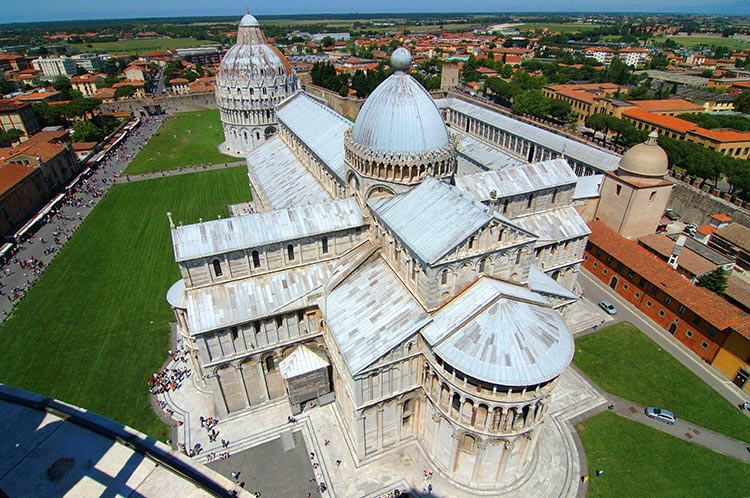 Above: Pisa Cathedral, 11th century, Pisa, Italy
Above: Pisa Cathedral, 11th century, Pisa, Italy
St. Maximus the Confessor and St. Sophronius see in the church the image of both the spiritual and the visible world, that is, the image both of what we perceive through the spirit and of what we perceive through our senses. They emphasize the cosmic importance of the church, as an image not only of the whole created world, but also of the transfigured world.
St. Germanus makes use of a kind of play on words in his commentary; he speaks of the Church as the Body of Christ and as a place of worship in the same terms, in the same phrases even, in order to stress that the second is but an image or the first. "The Church", he says, "is heaven on earth, where lives and dwells God, Who is higher than heaven". He continues: "It calls to mind the crucifixion, the burial and the resurrection of Christ, it is more glorious than the Tabernacle of the Covenant", which clearly refers to the place of worship. "It was prefigured in the patriarchs, founded on the apostles ... it was foretold by the prophets, adorned by the hierarchs, sanctified by the martyrs, and its altar is founded on their "holy relics", which once again consciously confounds the Church and a church, its image. Having stressed this analogy, St. Germanus goes on to comment on the place of worship: "The church", he says, "is a divine house where the mysterious and life-giving sacrifice takes place, where there is the inner sanctuary, the holy cave, the sepulchre, the soul-saving and life-giving food, where you will find the pearls of the divine doctrines which the Lord taught His disciples".
St. Simeon of Salonica also stresses this meaning of the church and explicitly states, among other things, that in the most solemn rite of consecration the church is revealed to us as "a mysterious heaven and the Church of the first-born". It is clear that the Church as described by the Fathers is not only the terrestrial Church as we know it, but also the celestial Church with which it is indissolubly linked; in other words, the Kingdom of God which will come in power when God shall be "all in all", in the words of St. Paul (I Corinthians xv, 28). This is why the church is the image of the "good things to come" as St. John of Damascus expresses it. St. Simeon of Salonica calls a church "paradise" and "gifts of paradise", for it contains not only the tree of life, but life itself, which is present in the sacraments and communicates itself to the believers.
Thus a church is a very complex reality, rich in content. On the one hand, it is a holy place where the members of the Church share through the sacraments in the divine life. The first-fruits of the Kingdom to come, it is thus a particle of this Kingdom, already existing on earth, and preceding its coming in glory. On the other hand, it is also an image of that divine Kingdom towards which the Church leads the world. This idea runs through all the patristic commentaries. And these commentaries are not confined to explanations of the church buildings in general: they also make clear the significance of each part.
In the Orthodox mind the patristic conception of the church and its parts remains immutable. Thus we read in recent works like The New Table of the Law, by Archbishop Benjamin, that the church is divided into three parts (the sanctuary, the nave and the narthex) according to the plan of the Tabernacle of Moses and the Temple of Solomon . Just as the people of Israel, the Church of the Old Testament, prefigured those of the New Testament, the Tabernacle and the Temple prefigured the holy places of the New Covenant which have preserved the same plan. For St. Simeon of Salonica this tripartition recalls the Holy Trinity, the three orders of the heavenly hierarchies, and the three categories into which Christian people are divided: clergy, believers and penitents, and catechumens.
The sanctuary is, in fact, reserved for the clergy. This is the most important part of the church, where the sacrament of the Eucharist is performed. It corresponds to the Holy of Holies of the Tabernacle. It is in a way the heart of the whole sacred edifice, the part which sanctifies it. It represents symbolically the dwelling place of God, "the heaven of heavens", as St. Simeon of Salonica wrote, or, in the words of St. Germanus, "the place where Christ, the King of all things sits enthroned with the apostles". The sanctuary is situated at the eastern end of the building, so that the whole church is turned towards the east. This feature is common to all Christian churches. The explanation lies both in the past and in the future, both of which the Church recalls to us: on the one hand, the lost paradise which was in the east, on the other hand, and above all, the coming of the future Kingdom, towards which the whole life of a Christian is directed. This Kingdom of God which is to come is often called, especially in the monuments of the first Christian centuries, the eighth day of creation. The coming of this "day without end", which we await and for which we are preparing, is symbolized by the rising of the sun, and hence by the east. This is why St. Basil prescribes, in his ninetieth rule, that we should always direct our prayers towards the east.
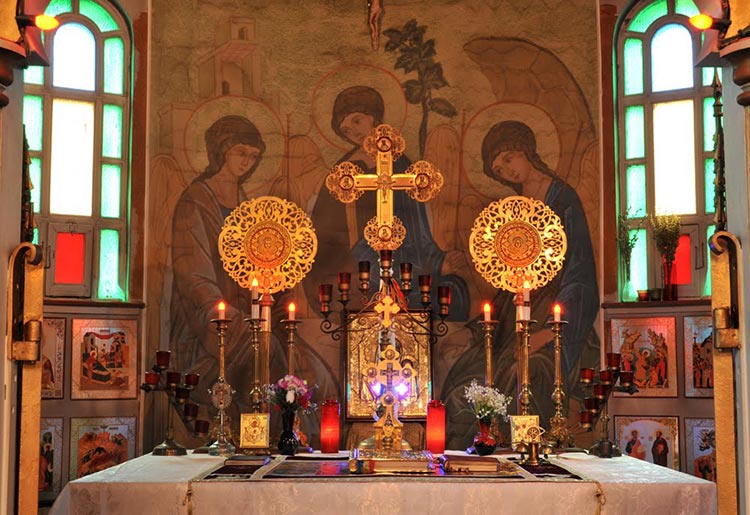 Above: Greek orthodox sanctuary / altar
Above: Greek orthodox sanctuary / altar
The middle part of the church, the nave, corresponds to the " Holy Place " of the Tabernacle, which was separated from the court-yard by a veil. There the priests came every day, bringing sacrifices. In the church of the New Testament it is the laity, the "royal priesthood, the holy people", in the words of St. Paul, who enter this part and offer God their prayers. This part of the church contains, therefore, people enlightened by the Christian faith, who prepare themselves to receive grace in the sacrament of the Eucharist. Having received this grace, they are redeemed and sanctified, they form the Kingdom of God . If the sanctuary represents that which surpasses the created world, the dwelling place of God Himself, the nave of the church represents the created world. But it is a world which is redeemed, sanctified, deified, the Kingdom of God, the new earth and the new heaven. This is how the Fathers describe this part of the church. Here, for instance, is what St. Maximus the Confessor says: "In the same way as the carnal and the spiritual principles are united in man, in such a way that neither does the carnal principle swallow up the spiritual nor the spiritual principle dissolve the carnal, but spiritualizes it, so that the body itself becomes an expression of the spirit, likewise in a church the sanctuary and the nave communicate with each other: the sanctuary enlightens and guides the nave and the latter thus becomes its visible expression. Such a relationship restores the normal order of the universe, which was turned upside down by the fall of man; it re-establishes, therefore, the conditions of paradise which shall be restored in the Kingdom of God " (9).
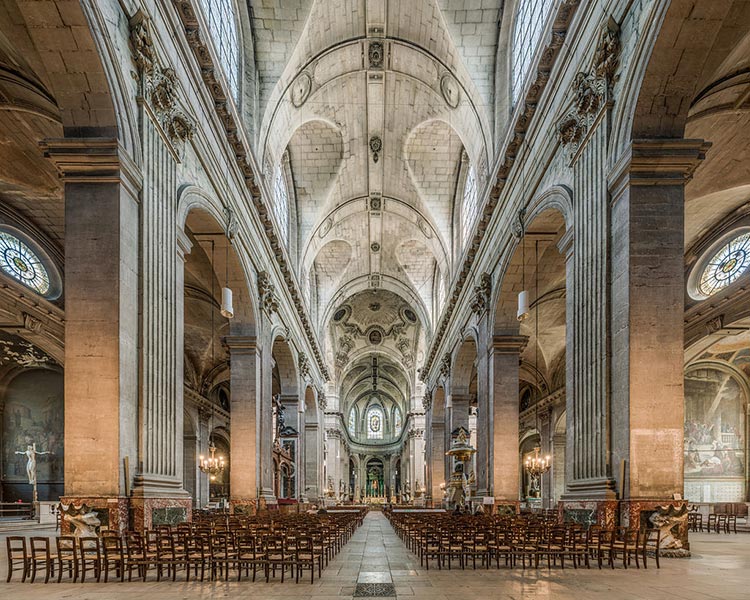 Above: The nave of the Saint-Sulpice Church in Paris, France
Above: The nave of the Saint-Sulpice Church in Paris, France
Finally, the narthex corresponds to the court-yard of the Tabernacle, the exterior part where the people stood. Nowadays, while the sanctified people have their place in the nave, it is the catechumens and the penitents who stand in the narthex, that is to say, those who as yet are only preparing themselves to enter the Church and those whom the Church places in the special category not admitted to the communion of the Holy Gifts. This explains why, when the sacrament is consecrated, those who cannot partake of it are asked to leave: some because they are not yet members of the Church, others because they have fallen away or are considered unworthy. Thus the very design of a church draws a precise boundary between those who participate in the Body of Christ and those who cannot do so. The latter are not turned away from the church, and may remain there up to a certain moment. But they cannot participate in the inner, sacramental, life of the Church. Their place is not completely outside the church, neither is it within. They are, so to speak, on the periphery, on the border-line between the church and the world. The narthex, according to the commentary of the Fathers, symbolizes the un-regenerate world, the earth which still lies in sin, sometimes even in hell. It is always situated on the side opposite the sanctuary, that is, on the west.
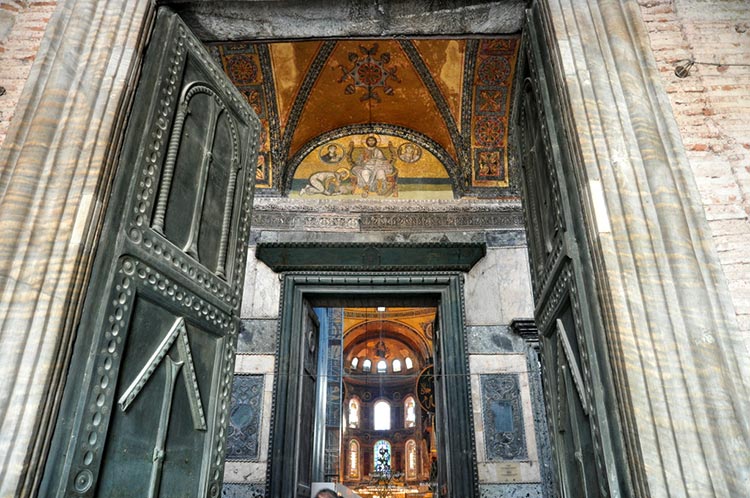 Above: The narthex of Hagia Sofia in Istanbul, Turkey
Above: The narthex of Hagia Sofia in Istanbul, Turkey
We speak of the devision of the church into three parts as being the most complete, the most usual, and the one which expresses most clearly the meaning of the Church.
But this division does not constitute an absolute rule. Only the sanctuary and the nave are absolutely indispensable: without them the church is not a church. But without the narthex it nevertheless remains a church. Certainly, in our present situation, a narthex seems desirable, even indispensable in our churches, for often people come to our services who are not members of the Church. These people attend our celebrations. They must be given the opportunity to find out what a church is and, through this, what the Church is, the Body of Christ.
To the "spatial" and permanent significance of the church must be added a temporal significance which changes at different times in the service.
Let us sum up the general meaning of the patristic commentaries: a church, a place of worship, is an image of the one, holy, catholic and apostolic Church; at the same time it is the first-fruits and image of the Kingdom of God which is to come. It is in order to give precision to this image and to suggest the presence of this Kingdom to come that the Church has recourse to images. The iconographical subjects of its decoration are distributed according to the meaning of each part of the church and its role in the service. If the symbolism of the Liturgy was commented upon by the Fathers during the pre-iconoclastic period, the relationship between the decoration of the church and this symbolism was elaborated after this period. The pattern of church decoration then established has the character of a clear and precise theological system.


